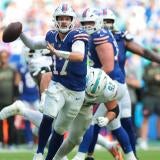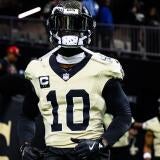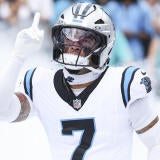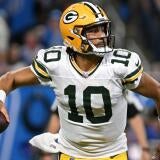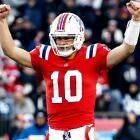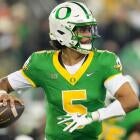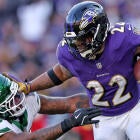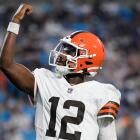Steelers' Franchise Five: Tough battle at QB highlights list of all-time greatest figures in team history
One of the franchise's biggest questions has been answered
"There are 29 teams in pro football, and then, there are the Pittsburgh Steelers."
That quote, offered by legendary NFL Films narrator John Facenda, was said at the beginning of the Steelers' 1979 highlight video. The quote perfectly summarizes the 1970s Steelers, a team that was, quite simply, in a league of their own. After four decades of futility, the '70s Steelers helped transform Pittsburgh into The City of Champions after becoming the first team to win four Super Bowls.
After a 26-year hiatus, Pittsburgh added to their Lombardi Trophy collection in 2005, with a new cast of characters leading the Steelers to another Super Bowl win. Many of those same faces helped Pittsburgh win another Super Bowl just three years later, as the Steelers became the first team in NFL history to win six Super Bowls. Throughout that time, the Steelers boasted some of best players in pro football history, players that helped create the current standard of excellence that permeates throughout the organization.
As part of CBS Sports' "Franchise Five" series, we've engaged in the tough assignment of determining the Steelers' greatest coach, quarterback and three other players that make up the five most prominent figures in franchise history. We arrived at these names with input from Steel City Insider's Jim Wexell; DK Pittsburgh Sports' Dale Lolley; 93.7 The Fan's Andrew Fillipponi; and J.J. Cooper, executive editor for Baseball America who also happens to be one of most knowledgeable Steelers historians.
While we were limited to just one quarterback for the CBS Sports Pittsburgh Steelers' Franchise Five, our esteemed advisors provided candidates for our list:
Wexell: Chuck Noll, Joe Greene, Ben Roethlisberger, Terry Bradshaw, Rod Woodson
Lolley: Noll, Roethlisberger, Greene, Mel Blount
Fillipponi: Noll, Bradshaw, Greene, Jack Lambert, Jack Ham
Cooper: Noll, Bradshaw, Greene, Woodson, Troy Polamalu
Coach Chuck Noll
Known as "The Emperor" in Pittsburgh, Chuck Noll helped turn the Steelers from a losing franchise into the NFL's most successful organization since the AFL-NFL merger. Noll, along with Steelers team president Dan Rooney and a talented scouting department, reshaped the Steelers through the draft, acquiring nine Hall of Fame players (and signing another Hall of Fame player, Donnie Shell, as an undrafted rookie) between 1969-74. These players, who meshed with other talented newcomers and a few holdovers from pre-Noll era (most notably linebacker Andy Russell and center Ray Mansfield), helped the Steelers win their first division title in 1972. Two years later, they won their first of four Super Bowls over a six-year span.
An education major in college, Noll was a teacher at heart, instructing his players to master their techniques and game plans in order to operate at a nearly flawless level on Sundays. And while he wasn't known as a motivator, Noll's speech to his team prior to the 1974 AFC Championship is regarded as the turning point in the history of the franchise. Noll's speech came after Raiders coach John Madden told Sports Illustrated that the Raiders and Dolphins were the league's two top teams following Oakland's playoff win over Miami.
Gary M. Pomerantz described the scene in his book, "Their Life's Word: The Brotherhood of the 1970s Pittsburgh Steelers."
"[Noll] told the Steelers what Madden had said and then, his eyes tightening at the corners, Noll said that Madden was wrong. 'The best team in the NFL,' Noll said, thumping his index finger on a table, 'is sitting right here in this room.'
"It took his players a moment to react, to decide whether their coach had just said what he had just said. Then their reaction was like a small dam breaking, hoots and howls, broad smiles and hand slaps, and Franco Harris saying 'Yep!' No player reacted more demonstratively than Joe Greene. ... Much as he respected Noll, Greene had long craved more emotion from his coach -- for his teammate, not himself -- and now he had gotten it. It wasn't what Noll said in the meeting room, or how he said it. It was simply that he said it. It caught Greene, and the entire team, by surprise."
The inspired Steelers wiped out the Raiders, 24-13, to advance to their first Super Bowl. Noll, the coach of the Super Bowl's Golden Anniversary Team, went onto became the first coach to win four Super Bowls and, a year after he retired, received induction into the Pro Football Hall of Fame.
QB Ben Roethlisberger
The Steelers had some very good teams from 1984-2003, but were unable to add to their Lombardi Trophy collection during that span largely because of the quarterback position. While Neil O'Donnell and Kordell Stewart led the Steelers to four AFC title games between 1994-2001, Pittsburgh came up short in three of those games. And after defeating the Colts in the 1995 AFC title game, three O'Donnell interceptions largely contributed to Pittsburgh's loss to Dallas in Super Bowl XXX.
Pittsburgh's championship drought shortly ended after the team drafted Ben Roethlisberger in 2004. As a rookie, Big Ben helped lead the Steelers to a 15-1 record and trip to the AFC title game. But after a tough showing against the Patriots in the AFC Championship, Big Ben vowed to get the Steelers to the Big Game in 2005, coaxing Jerome Bettis to delay retirement another year. Roethlisberger backed up his talk with his play, leading the Steelers to three road playoff wins before Pittsburgh defeated Seattle in Super Bowl XL. Three years later, Roethlisberger led the Steelers to their sixth Super Bowl win, throwing the game-winning touchdown pass to Antonio Holmes in the final minute of Pittsburgh's win over Arizona in Super Bowl XLIII.
After helping lead the Steelers to another Super Bowl in 2010, Roethlisberger has re-written the Steelers' record books. The franchise's all-time leader in just about every passing category, Big Ben is eighth all-time in career passing yards (56,545) and ninth with 363 career touchdown passes. His 157 career victories as the Steelers' starting quarterback is the sixth-highest total in league history.
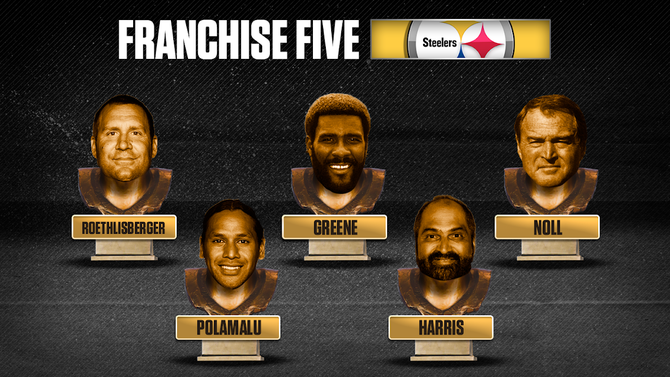
DT Joe Greene
Regarded as the greatest player in franchise history, Greene's No. 75 was officially retired by the team in 2014. Chuck Noll's first-ever draft pick, Greene immediately added a spark to a Steelers franchise that sorely needed one. A two-time Defensive Player of the Year, Greene was virtually unblockable during his heyday, as his lethal combination of speed and power made him a regular in opposing backfields.
Greene's greatness was complemented by a group of defensive teammates that became known as the "Steel Curtain." With Greene leading the way, Pittsburgh's defense, a unit that also included L.C. Greenwood, Dwight White, Ernie Holmes, Dwight White, Jack Lambert, Jack Ham, Andy Russell, Mel Blount, Mike Wagner and Donnie Shell, shut out the Vikings' offense in Super Bowl IX. While running back Franco Harris was the game's MVP, Greene put up a convincing argument, as he came down with a key interception as well as a fumble recovery near Pittsburgh's goal line. Greene continued to grow as a leader as the Steelers' championship run continued, as he became the face of arguably the greatest dynasty of the Super Bowl era.
S Troy Polamalu
The Steelers traded up in the 2003 NFL Draft to land Troy Polamalu, but if an offseason deal with free agent Dexter Jackson hadn't fallen through, Pittsburgh wouldn't even have been in the market for a safety. But Jackson signed with the Cardinals, and the Steelers moved up from No. 27 to No. 16 (and all it cost them was the 92nd and 200th picks) to grab the Hall of Famer.
Polamalu's professional career got off to a rocky start; he didn't start once as a rookie and featured primarily on special teams, but it all came together in Year 2 when he had five interceptions and 14 passes defended. For much of the next 11 seasons he always one of the best players on the field, coming up with career-defining plays in seemingly every big game. Polamalu was a first-ballot Hall of Famer whose approach redefined how the safety position is now played.
"He had great acceleration, he could go from point A to point B like no one I've ever seen and he was over 200-pounds so that's a very rare combination," former Steelers defensive coordinator (and Hall of Fame defensive back) Dick LeBeau said of Polamalu shortly after his retirement. "I don't know if I've ever seen anybody from the safety position that could close on the ball as fast as Troy Polamalu. When he got there, he had enough power to make something happen. He was a rare, rare player. The best safety I've ever seen."
RB Franco Harris
The Steelers had never won a playoff game or a division title before Franco Harris came to Pittsburgh in 1972. But that season, the 40th year of the franchise's existence, Harris injected a bolt of energy into the Steelers and Pittsburgh. In '72, Harris led the Steelers to their first-ever division title. Trailing late in Pittsburgh's playoff battle with Oakland, Harris' "Immaculate Reception" led the Steelers to their first postseason victory.
A Pro Bowler each season from 1972-79, Harris was the focal point of Pittsburgh's offense during their first two Super Bowl runs. In the '74 playoffs, Harris' 343 yards and six touchdowns led the Steelers to victories over Buffalo, Oakland and Minnesota. Against the Vikings in Super Bowl IX, Harris ran for a then-Super Bowl record 158 yards and a touchdown in Pittsburgh's 16-6 victory.
Harris, who teamed up with Rocky Bleier in 1976 to become the second pair of teammates to rush for over 1,000 yards in the same season, had a flair for making big plays in big games. With the Steelers holding a slim lead late in Super Bowl XIII, Harris bolted through the middle of the Cowboys' defense for a back-breaking, 22-yard touchdown run. The run helped Pittsburgh defeat Dallas 35-31 while solidifying its place as the Team of the Decade. The following year, in Super Bowl XIV, Harris' two touchdown runs helped propel Pittsburgh to a 31-19 win over the Los Angeles Rams.
A first-ballot member of the Pro Football Hall of Fame, Harris remains the franchise's all-time leader in career rushing yards (12,120) and rushing touchdowns (91). He also rushed for 1,556 yards and 16 touchdowns in postseason competition.
Honorable mentions
Bill Cowher recently called cornerback/return specialist Rod Woodson, the 1993 Defensive Player of the Year, the best player he coached during his 15 years in Pittsburgh. Other players that received consideration include quarterback Terry Bradshaw, cornerback Mel Blount and linebackers Jack Lambert and Jack Ham. Bradshaw, a two-time Super Bowl MVP and the 1978 NFL MVP, would have been on the list had we been able to include more than one quarterback.
Blount, the 1975 Defensive Player of the Year, was so dominant that the NFL changed the rules regarding pass coverage in 1978. Lambert, one of the most intimidating figures in NFL history, was named the Defensive Player of the Year in 1976. Tony Dungy, a Hall of Fame coach and former Steelers cornerback, once called Ham the best outside linebacker he has ever seen.



